|
Michael McFadyen's Scuba Diving - Clifton Gardens
I first visited Clifton Gardens in the mid-1960s when the junior rugby league football club that I played for regularly held their annual end of season picnic there. Clifton Gardens was then an old time picnic ground (it opened on Christmas Day 1863), with a wharf, bathing enclosure and shelter sheds being the most prominent features. There was even a dancing hall and skating rink! The shelter sheds are now gone (perhaps they were the remains of hall and rink) but the local council has spruced the area up and it is an excellent place for families and groups to picnic. The water is shallow and, of course, protected (well, allegedly) inside the shark net enclosure. Clifton Gardens is an excellent site for beginners but like a lot of other harbour dive sites, it is a bit too easy and sometimes not that interesting for experienced divers in the day-time.
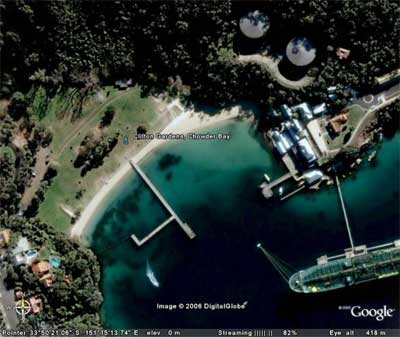 | 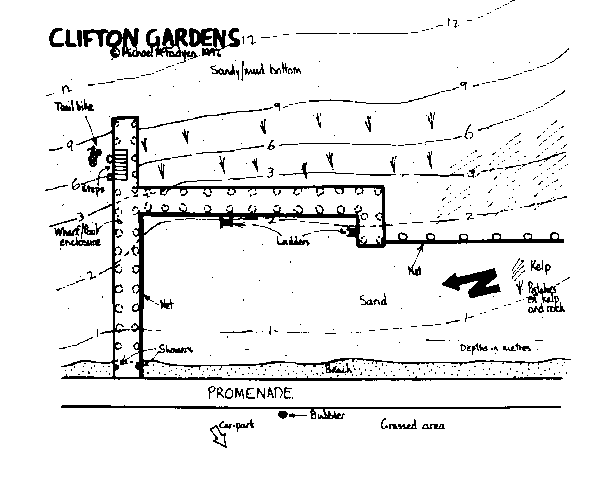 |
| A satellite photo of Clifton Gardens | A map of Clifton Gardens I drew in 1992
Click to enlarge |
Located on the northern side of Sydney Harbour just around from Bradleys Head and Taronga Zoo, Clifton Gardens can be accessed off Bradleys Head Road at Mosman. Turn into Thompson Street (the last street on the left before the Zoo and Sydney Harbour National Park) and then (almost straight) into David Street. A hairpin turn at the end of David Street brings you into Morella Road, Clifton Gardens. The picnic grounds themselves are at the bottom of the winding road that comes off Morella Road about 50 metres from the hairpin.
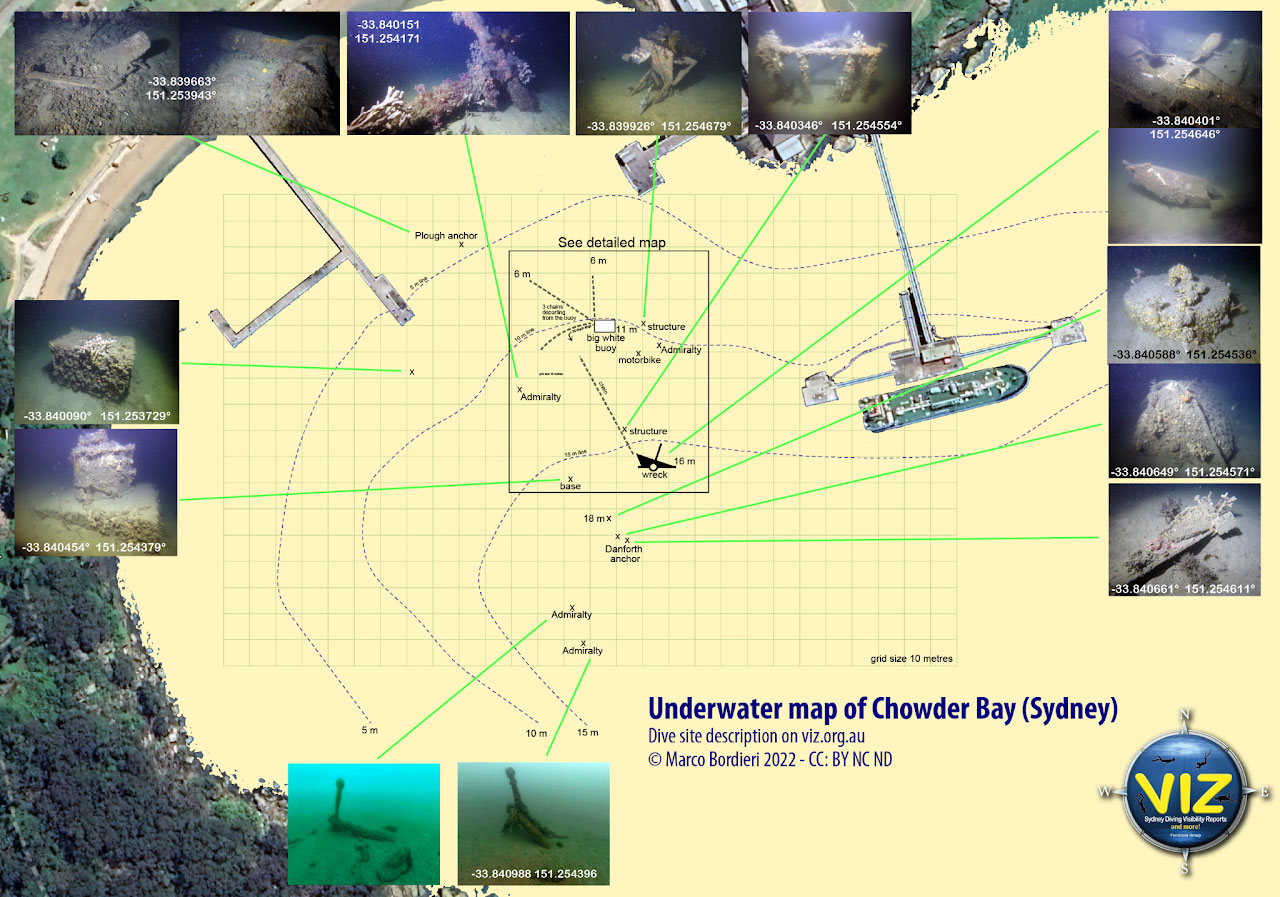 |
| A map of Clifton Gardens and Chowder Bay produced by Marco Bordieri - used with permission of Sydney Viz web site - see below for enlargement of the middle section |
A large parking area is provided and at night or late evening there will be no problem finding a spot. However, note that Mosman Council charges an exorbitant fee for parking (on weekends it is a minimum of $8 for one hour and it gets worse, maximum of $28 for the day) and you get absolutely no facilities other than some dirty toilets (well, they used to be, at least there are new ones now) and the shark net (which if you knew what it was like and wanted it to actually protect you you would want your money back - see later). There are not even barbecues that councils on the southern side of the Harbour provide free. However, at night (after 8 pm - it used to be 6 pm) you do not need to pay. So for summer night dives you can do for free. A total rip off of the highest order.
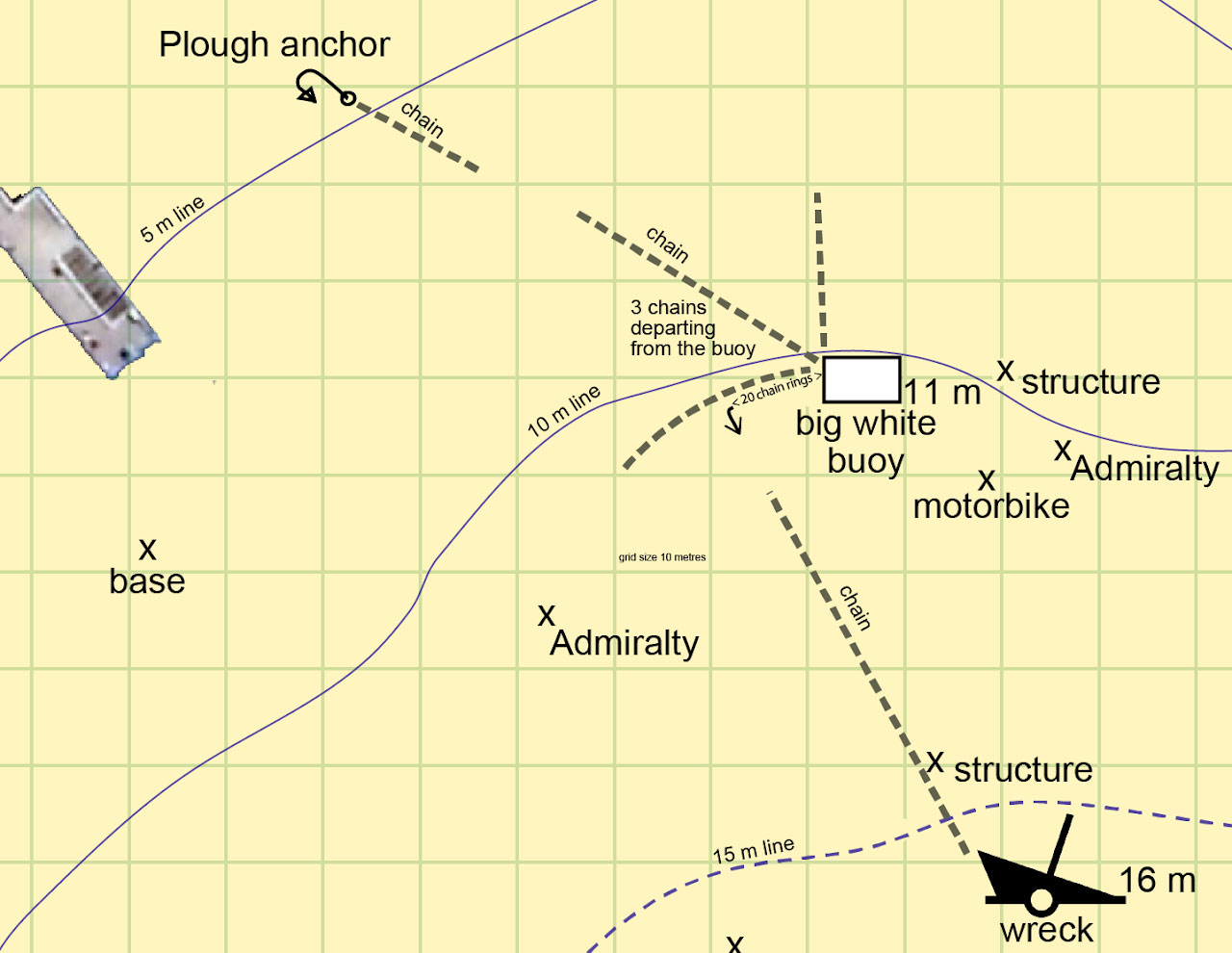 |
| An enlargement of the middle section of Clifton Gardens and Chowder Bay produced by Marco Bordieri - used with permission of Sydney Viz web site |
There are a number of dives that can be done in this area. The dive main one is around the wharf and bathing enclosure. As indicated above, the dive is much better when night has fallen. While the visibility here is never really more than fair, the night can give the keen diver a memorable dive with the highlight being the anglerfish that can more easily be seen at night. There are also sea horses that frequent the area. I can almost guarantee that you will see at least a couple of sea horses on this dive, so if you have never seen one, dive Clifton Gardens. It is also the most reliable place I know to find anglerfish.
HOW I USED TO DIVE HERE
After gearing up it is a short easy walk from the parking area across the grassed area and down the wharf. Near the end of the wooden structure, part of the wharf steps down to the water level. An easy giant stride and you are in the water.
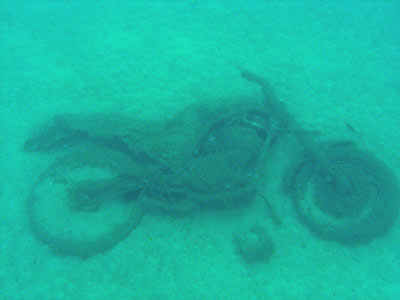 | 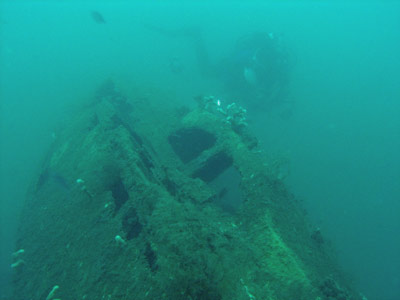 |
| The motor bike under the wharf | One of the wrecks, this is the yacht.
This was taken about 2010, as of 2024 it has
totally collapsed and almost flat. |
Because of the shallowness of the water on this dive, it is preferable to dive this site at high tide and if you are a bit light on lead, you might add some weight to keep you down at the end of the dive (I always add 3 pounds). At low water there can be as little as 2 metres of water over a large part of the dive route.
Once in the water, sink to the bottom where it is 8 to 10 metres deep. At the time of writing (I think this was originally written in about 1992), a dumped trail bike was located straight below the entry point (in March 2020 it was under the wharf and all that was recognisable was a wheel and the frame). Swim out around the end of the wharf and begin working your way back towards the shore. After 10 metres turn to the south and follow the 8 to 9 metre contour. Travel slowly, checking each piece of wood, rock and kelp for sealife. When you have been in the water for 20 minutes, turn to the west and gradually the depth will come up to 2 to 3 metres. Just before you reach the shark net you will go over a large area of kelp.
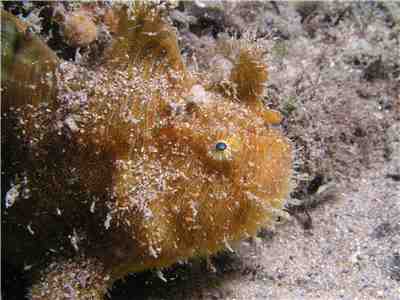 | 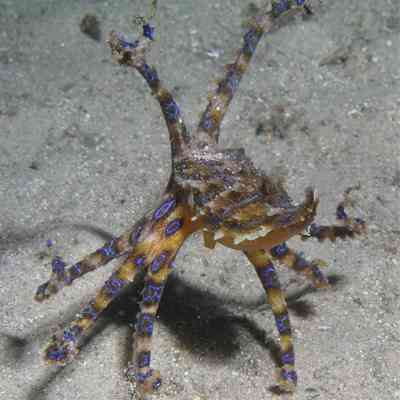 |
| A striped anglerfish at the southern end of the net | Possibly the deadliest marine creature alive and only 150 mm high -
this blue ringed octopus walked across the bottom |
At the net go to your right and follow it all the way back to the main part of the wharf. Examine each pole along the way as you are certain to see sea horses on some of them. These are mostly White's sea horses, also known as the Sydney or common sea horse although you might see some big-bellied sea horses. At times there are huge holes in the net through which you can go and look at the abundant fishlife on the inside. While in January 2007 there was a relatively new net in place, in June 2011 the net has at least a dozen huge holes in it, most big enough for a great white shark to get through. There were the same number in February 2024! You will see what my comment about paying to park here when the facilities are crap. When a new net is placed here, it is usually set inside the old net so that the growth and sea horses were able to remain in place.
When you reach the proper part of the wharf (where the depth is 3 to 4 metres), you can either turn to the right and go to the end of the wharf where you can exit back onto the steps, or you can go to the left and exit onto the beach. It is best to go to the beach. You can also go through one of the holes and examine the net from the inside and exit on the beach.
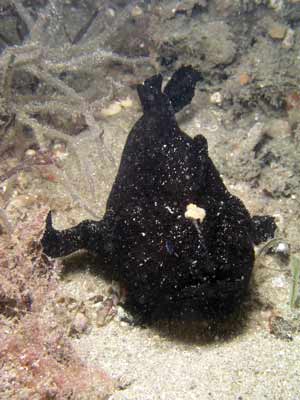 | 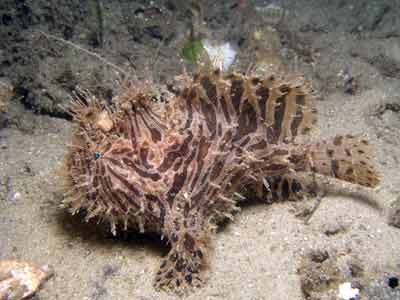 |
| A black anglerfish | Another striped anglerfish |
An alternative to the above is to go back under the wharf examining every pylon. When you are again heading back towards the shore and when you reach the shark net again, follow it to the left (south). All along here there are sea horses. I have seen as many as five within a few inches of each other. As you go, keep an eye open for other interesting things like blue-ringed octopus. The net runs south for about 20 metres and then turns west for about 15 metres before again turning south (left). During times of poor visibility it can be difficult to actually figure out when the net changes direction.
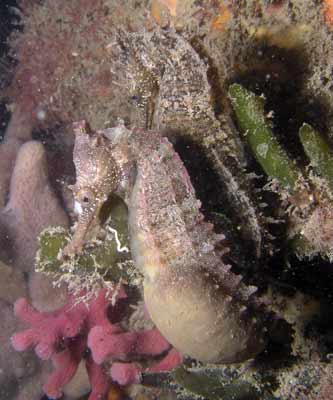 | 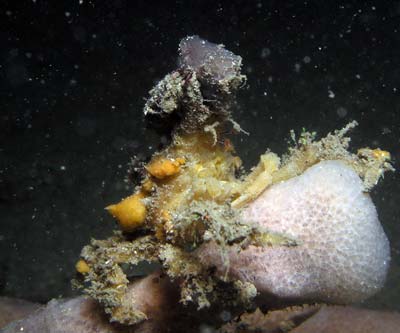 |
| Two Whites sea horses, one very pregnant | A decorator crab
The yellow bit is the body |
When you get to about 2 to 2.5 metres (at high tide), look on the sand for anglerfish. I have seen a number here, up to four on a dive. Anywhere under the wharf/pool structure and near the net is likely. From here you can either go back the way you have come and then under the wharf back to the beach or go under the big gap in the net and cross the pool, exiting on the beach.
HOW I DIVE THIS SITE NOW
I now start the dive on the beach to the right side. There is a sloped sand area that gives easy access to the beach. Walk out a little and start the dive. It is very shallow, less than 1.5 metres at most tides. Swim east-south-east and you will soon reach the shark net near the closet section of the timber part of the swimming enclosure. This is a corner where the shark net changes direction. Follow the net and straight away you will see huge holes in the net!
Cheak out the net for Whites sea horses and the sand for pipefish, anglerfish and sometimes nudibranchs. You may also see blue-ringed/lined octopus. You will normally pass some more huge holes, I take one of the ones a bit further on and on the way back one of the first ones you have seen. Once on the outside, continue following the net to the north-east.
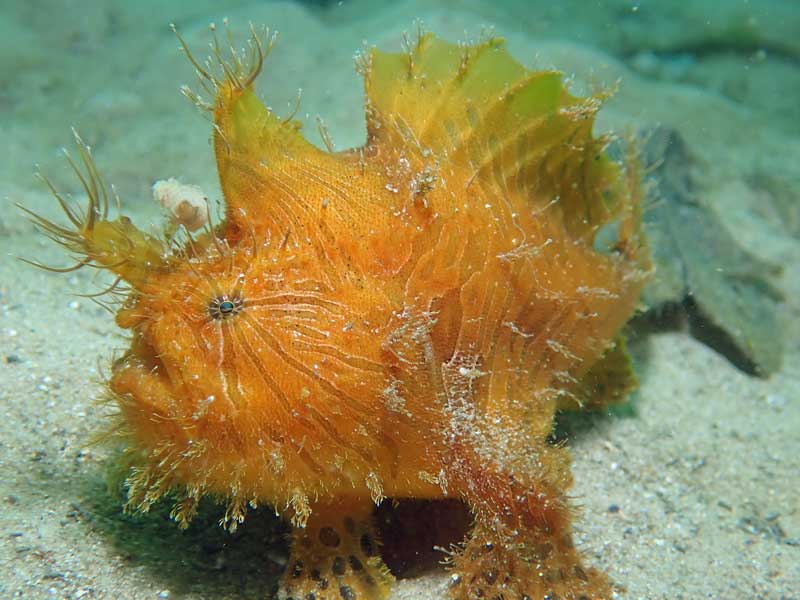 | 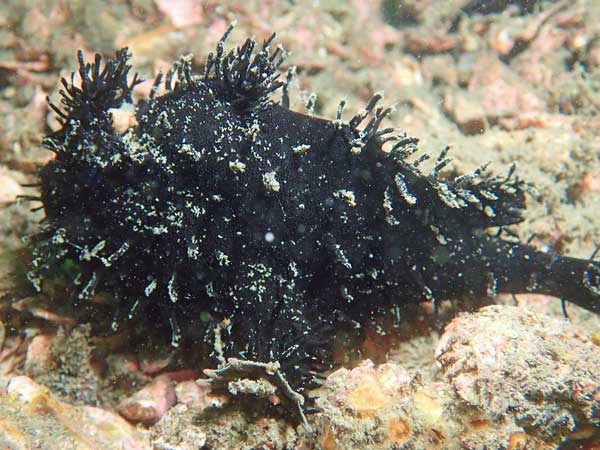 |
| An orange striated anglerfish | Another black striated anglerfish |
After a shot time you will come to the main part of the wharf which runs north-west to south-east. Turn right and head down the lefthand side of the wharf. There are many pylons and also on the sand, some old sections of the wharf and other junk. Check them all out as you can find some very interesting creatures at times. The main things are Whites sea horses on the sponges on the pylons and junk, straited anglerfish on the sand, octopus, pipefish and blue-ringed octopus.
At times you can see four or more anglerfish, people in early 2024 were seeing up to 12 on a dive. Be careful and do not spend too much time wandering out from under the wharf as there is a big chance you will get hooked by a fisher on the wharf. In February 2024 I got hooked twice and I was only a half metre from the edge of the wharf. On the south-western side there is a large PVC pipe which has a cap on it. This is for putting fishing tackle in.
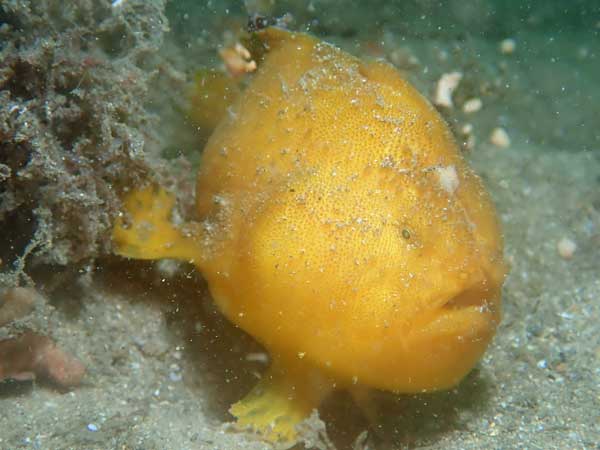 | 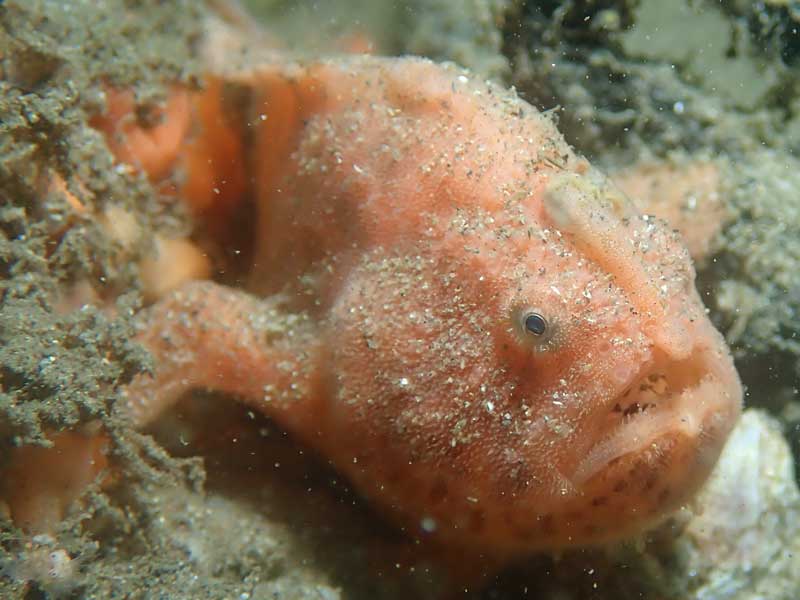 |
| An yellow striated anglerfish | A pinkish striated anglerfish |
Once you reach the end of the wharf, go to the other side and head back along this side. When you get about halfway back, torn left and head south-west. After about 15 metres or so you will see a pile of concrete Bessa blocks. This are forming a reef. There is also a small statue done up as a diver and to the north-west from here about five metres away a large Easter Island statue. Return back to the wharf.
Once back at the wharf, turn left and then when you get to the main swimming structure, turn left and head south-west on the outside of the net. Again, check out the net, the old nets and all the junk for creatures. When you get to the end of the first section, turn to the south and head off a little deeper. After perhaps 20 metres you will see a few things.
The first is a large anchor which I presume is similar to the ones at the Chowder Bay dive site (sort of part of this dive too). Past here are some things which at first you might not realise what they are. They are steel reinforcing sections. Originally they were sea horse hotels in the shape of a low box. However, as of early 2024, the majority of the older ones have fallen apart and collapsed flat on the sand. Further on there are some more which are more intact, but missing the tops.
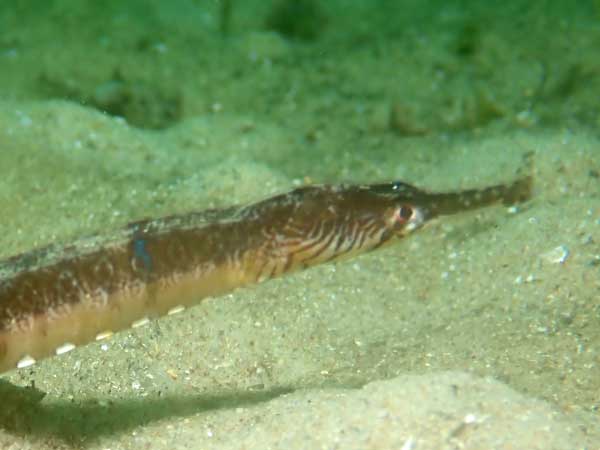 | 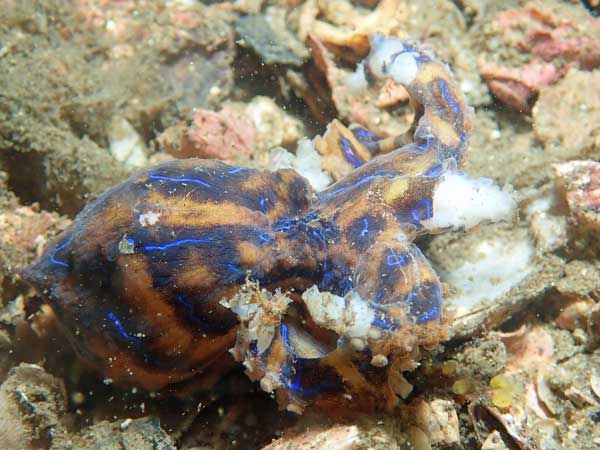 |
| A pipefish | A Blue-ringed octopus that has lost most of its arms |
Just past here are some new ones which are intact but which (in early 2024) have no growth on them. I have very rarely ever seen a sea horse on one of these hotels, in fact, I think I have only seen one! In my view they have been a total failure, as the ones in Nelson Bay at The Pipeline are also devoid of sea horses.
Once you have finished here, head back the way you came to the net and then go through one of the holes to the inside. Spend some more time inside and then head back along the net to where you first met it. Then head west-north-west and you will end up back on the beach.
A great deal of the attraction of this dive is the macro life that is abundant under the wharf and bathing enclosure. Ideal for macro-photography, things to look for include cuttlefish, lined-dumpling squid, prickly and pygmy leatherjacket, moasic moray, crabs and small and large octopus. Other fishlife to be found here includes estuary catfish, snapper, bream, whiting, old wife, snakeskin and senator wrasse, rough and yellow-finned leatherjacket, blackspot and blue-spotted goatfish as well as black sole.
If you look carefully on the pylons you will see the incredible decorator crab. These crabs look like sponges as they have large sponges growing on their shells. You will have to look very hard to see them.
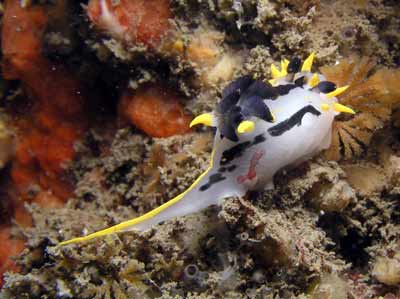 | 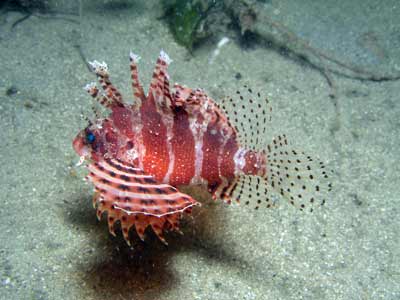 |
| A new nudibranch I had never seen before | A dwarf firefish |
Another dive to do here spends the first part of the dive in deeper water between Chowder Bay wharf and the Clifton Gardens wharf. See the Chowder Bay page for more details.
Visibility is normally never very good on this dive, normally about three to five metres. On a dive here in January 2002, we had only one metre visibility at high tide but it was still interesting! However, visibility can be as good as 10 metres. This is a good dive and can be dived at any time. It is a good fall back when the ocean is too rough. Incoming or high tide is normally the best, but at times low tide can be as good.
Worth doing a lot of times.
| 
 v6.00.307 © 2003-2005
v6.00.307 © 2003-2005